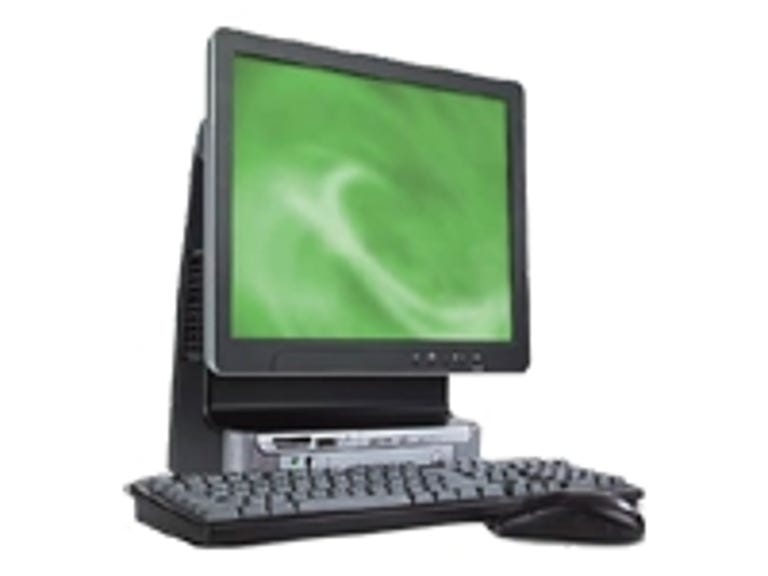 Why You Can Trust CNET
Why You Can Trust CNET Gateway Profile 5.5 (Pentium 4 2.8 GHz review: Gateway Profile 5.5 (Pentium 4 2.8 GHz
Gateway's well-designed update to the Profile all-in-one series looks good and performs admirably, but we're not convinced it's worth the added cost.
Gateway claims a fleet of its Profile 5.5 all-in-one desktops can save a small or midsize company up to 4 percent in IT costs. But if you're spending at least 4 percent more on the systems to begin with, is that smart business?
That's the conundrum presented by the Profile 5.5, the newest version of Gateway's undeniably sleek, space-saving all-in-one PC. Yes, it looks cool and saves space. Students and apartment dwellers will love its tiny footprint, and we can also see a row of these beautiful babies sitting behind a reservation desk in a world-class hotel or in the public spaces of a private bank. Coupled with Gateway's Custom Integrated Solutions (CIS), including specialized software and hardware installations and system management services, the new Profiles can save your company money on setup and maintenance, but at $1,869 (as configured for our testing), a single Profile 5.5 costs a few hundred dollars more than a comparable mainstream tower PC, even with the monitor included.
The Good
The Bad
The Bottom Line
Judged purely as a midrange computer, the Gateway Profile 5.5 makes a strong case for itself. Our test unit came with a 3.2GHz Pentium 4 540 processor, 512MB of 400MHz DDR memory, and Windows XP Professional. Gateway offers the Profile with three different LCDs, ranging from 15 inches to 19. Ours came with the midrange and very bright 17-inch screen, which sits atop a sturdy base that includes speakers and most of the system's components.
A very cool two-way hinge behind the display allows you to adjust the screen's height and angle with ease, and overall we loved the Profile 5.5's curved edges and consistent industrial design. The matte-black finish and the silver accents carry though to the included wireless keyboard and mouse. Although you can choose from a host of optical-drive options, our test system's base contained a DVD burner along with a handy 9-in-1 flash-media reader. You'll also find a PC Card slot plus two FireWire and four USB 2.0 ports, which make this PC very flexible for working with digital cameras and other peripherals. The Profile 5.5's built-in speakers were actually pretty good, but if you plan on listening to more than Internet radio, we suggest you select an inexpensive three-piece external speaker system.
In testing, the Profile 5.5 delivered just slightly below average performance for this processor class but was still robust enough for any office task; its overall SysMark 2004 score of 179 placed it smack in the middle of other comparably configured business PCs. Frame rates of about 80 frames per second in our 1,024x768 Unreal Tournament 2003 test show that the Profile will suffice for older 3D games and most basic graphics work, courtesy of a low-profile ATI Radeon X300 PCI-Express graphics card, but any new after-hours games should be played elsewhere.
The quoted price includes a three-year parts, labor, and onsite warranty with three years of 24/7 toll-free technical support. Gateway's excellent service and support options allow you to upgrade your warranty in a variety of ways, up to a five-year, all-inclusive warranty for $159.
(Longer bars indicate better performance)
| BAPCo SysMark 2004 rating | SysMark 2004 Internet-content-creation rating | SysMark 2004 office-productivity rating |
To measure application performance, CNET Labs uses BAPCo's SysMark 2004, an industry-standard benchmark. Using off-the-shelf applications, SysMark measures a desktop's performance using office-productivity applications (such as Microsoft Office and McAfee VirusScan) and Internet-content-creation applications (such as Adobe Photoshop and Macromedia Dreamweaver).
(Longer bars indicate better performance)
| Unreal Tournament 2003 Flyby-Antalus 1,024x768 |
To measure 3D gaming performance, CNET Labs uses Epic Games' Unreal Tournament 2003, widely used as an industry-standard benchmark. We use Unreal to measure a desktop's performance with the DirectX 8.0 (DX8) interface at a 32-bit color depth and at resolutions of 1,024x768 and 1,600x1,200. Antialiasing and anisotropic filtering are disabled during our 1,024x768 tests and are set to 4X and 8X respectively during our 1,600x1,200 tests. At this color depth and these resolutions, Unreal provides an excellent means of comparing the performance of low-end to high-end graphics subsystems. We report the results of Unreal's Flyby-Antalus test in frames per second (fps).
Read more about how we test desktops.
Dell OptiPlex GX280
Windows XP Professional SP1; 3.2GHz Intel P4 540; Intel 915G chipset; 512MB DDR2 SDRAM 400MHz; 64MB ATI Radeon X300 (PCIe); Seagate ST3160023AS 160GB Serial ATA 7,200rpm
Gateway Profile 5.5
Windows XP Professional SP2; 3.2GHz Intel P4 540; Intel 915P chipset; 512MB DDR SDRAM 400MHz; 64MB ATI Radeon X300 (PCIe); Seagate ST3160023AS 160GB Serial ATA 7,200rpm
HP Compaq Business Desktop dc7100
Windows XP Professional SP1; 3.2GHz Intel P4 540; Intel 915G chipset; 512MB DDR SDRAM 400MHz; 128MB integrated Intel 915G (shared memory); Seagate ST380013AS 80GB Serial ATA 7,200rpm
MPC ClientPro 414 All-In-One
Windows XP Professional SP2; 3.2GHz Intel P4 540; Intel 915P chipset; 1,024MB DDR SDRAM 400MHz; 128MB ATI Radeon Mobility X600 (PCIe); Seagate ST3160023AS 160GB Serial ATA 7,200rpm
Sony VAIO PCV-RS630G
Windows XP Home SP1; 3.2GHz Intel P4; Intel 865PE chipset; 512MB DDR SDRAM 400MHz; 128MB ATI Radeon 9200 (AGP); WDC WD2500BB-98FTA0 250GB 7,200rpm
